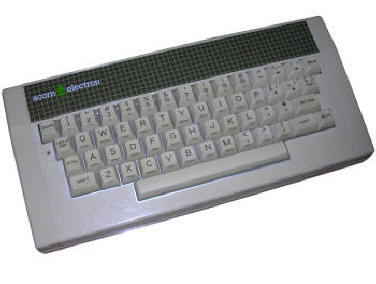Acorn Electron
Electron was designed to be a cheap home computer, a
cost-reduced version of BBC Micro. It was designed in 1982-1983 and
released before Christmas 1983. It was cheap, but there were many
manufacturing problems with it, so for Christmas period not many
machines were actually available. To correct technical problems, Acorn
decided to use less chips - after shrinking BBC's logic to one ULA,
which was a goal of Electron, they removed a ROM switching and second
16K
ROM, putting kernal and BASIC to one 32K ROM chip. Electron had some
graphical capabilities, but it was slower than, for example, Spectrum
and had sound capabilities smaller then "gaming microcomputers" such as
Atari or Commodore. It also had less RAM.
There were many problems with early Electrons. It used dedicated ULA
circuit, manufactured by Ferranti, to handle most of system logic. This
circuit was big, hot and had problems with proper sitting in its socket,
which lead to continuous beeping problem. Later it was soldered in, so
there were problems with solders.
| Manufacturer | Acorn | |
| Origin | UK | |
| Year of unit | 1984? | |
| Year of introduction | 1983 | |
| End of production | ??? | |
| CPU | MOS 6502 | |
| Speed | 1MHz | |
| RAM | 32K | |
| ROM | 32K (Kernal, BASIC) | |
| Colors: | Maximum 16 | |
| Sound: | 1-channel, noise, 3 virtual channels | |
| OS: | BASIC | |
| Display modes: | Text: 20x32, 40x25,
40x32, 80x25, 80x32 Graphics: 160x256x4, 320x256x4, 640x256x2 |
|
| Media: |
Tape ROM expansions with system bus |
|
|
Power supply: |
||
|
19V AC between 1 and 2. Please DO NOT USE DC! |
||
| I/O: | System bus, Tape I/O RGB, composite, RF out |
|
| Possible upgrades: | With expansion boxes applied to system bus. | |
| Software accessibility: | Quite easy (TOSEC, sites) |
I have NO IDEA about history of my unit. It's very clean, both inside and outside. There are no traces of dust, even under PSU board. Outside it's very clean too. It takes a day or two for an experienced collector to make it such clean. The only sign of opening is a "1311" text and a square written inside with ball pen.
| Contents: | Starting, battery, usage | Recording media | Pinouts | Links |
Starting
The machine just boots up to Acorn BASIC in two beeps.
If you hear one continuous beep, check ULA and memory first. Is ULA
sitting firmly in socket? Re-seat it by removing socket lock wire, then
opening metal piece.
Continuous beep + bright, distorted screen is usually cause of ULA not
fitted properly in socket. ULA rarely fails in Acorns, it usually fails
when something is going wrong with expansions.
If keyboard doesn't work - is the conductive ribbon in on piece? Aren't
there any broken tracks?
From BASIC you're ready to work with cassettes:
CHAIN"PROGNAME" - loads program from cassette and runs
it
LOAD"PROGNAME" - loads BASIC program from cassette
SAVE"PROGNAME" - explained...
During looking for programs their names are displayed. If there's an
error, you can see something like:
150 PRINT?%#ESULT IS"
DATA?
REWIND TAPE
It means: "What the hell is this gibberigh thing I got?"
Recording media
There are 3 types of files:
- WAV - self-explainatory
- CSW - Compressed Square Wave - use BackToLife to convert it back to WAV,
use CSW Viewer to create them.
- UEF - More sophisticated. Use FREEUEF to play/convert them,
MakeUEF
(see TAPE><PC TRANSFER chapter)
to make them.
Tape to PC: Record to WAV, use MakeUEF.
PC to tape: Use FreeUEF/Back To Life
TAP files should be played as typical Commodore/Spectrum TAP files.
Important Pinouts:
RGB Pinout:
|
|
| 1 - Red 2 - Green 3 - Blue 4 - Sync 5 - GND 6 - +5V |
Tape connector:
|
|
| 1,4 - Output 2 - GND 3 - Input 5 - N.C. 6,7 - MOTOR CTRL RELAY |
Sytem bus:
|
1 3 5
7 9 11 13 15 17 19 21 23 25 27 29 31
33 35 37 39 41 43 45 47 49 |
|||||||||||||||||||||||||||||||||||||||||||||||||||||||||||||||||||||||||||||||||||||||||||||||||||||||||||||||||||||||||||||||||||||||||||||||||||||||||||||||||||||||||||||||||||||||||||||||||||||||||||||||||
|
|
||||||||||||||||||||||||||||||||||||||||||||||||||||||||||||||||||||||||||||||||||||||||||||||||||||||||||||||||||||||||||||||||||||||||||||||||||||||||||||||||||||||||||||||||||||||||||||||||||||||||||||||||
Links:
http://web.archive.org/web/20030403011859/http://www.landfield.com/faqs/acorn/games/
- Acorn Games FAQ
http://www.acornelectron.co.uk/ - Acorn Electron World -
Games descriptions, Emulators, Information
http://bygonebytes.co.uk/electron.html - Electron owner
describes his experiences.
http://lionels.orpheusweb.co.uk/CompNyb/TechStuff/8-Bit/Electron/Electron.html
- See this Electron - that's how it's expanded
http://8bs.com/ - Much interesting stuff.
http://bbc.nvg.org/ - "The BBC Lives!"
http://www.stairwaytohell.com/
- BBC Micro and others archive.
http://8bs.com/manuals.htm#manuals - Manuals for Acorn and BBC computers
- You can get Electron manual here.
http://mdfs.net/ - Software for Acorn
http://web.archive.org/web/20090130090248/http://bbcdocs.com/ -
Now-defunct site containing documentation.






